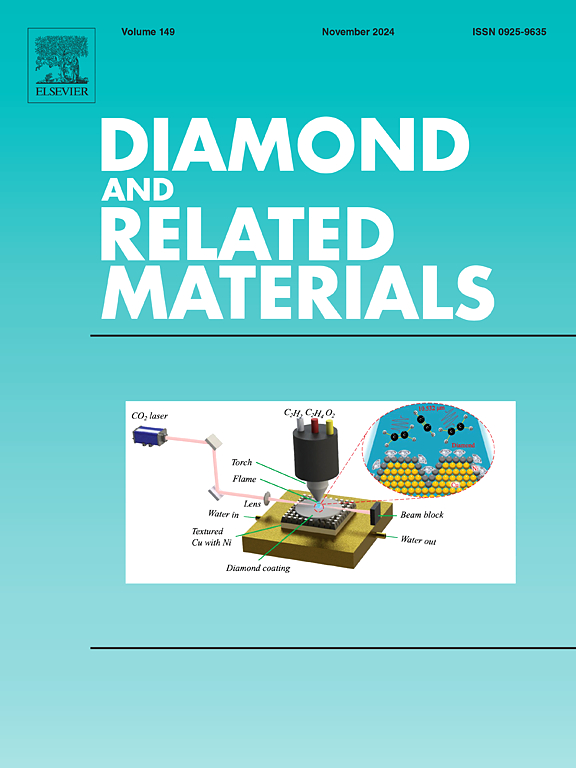Plasma sprayed Cr3C2-NiCr coating with in-situ exfoliated graphene for enhanced corrosion resistance
IF 5.1
3区 材料科学
Q2 MATERIALS SCIENCE, COATINGS & FILMS
引用次数: 0
Abstract
This study investigates the enhancement of corrosion resistance in Cr3C2-NiCr coatings through the incorporation of in-situ exfoliated graphene via plasma spraying. Three coating compositions were examined: pure Cr3C2-NiCr, and those reinforced with 1 wt% and 2 wt% graphene. Electrochemical tests in 3.5 wt% NaCl solution revealed significant improvements in corrosion resistance with graphene addition. The 2 wt% reinforced graphene Cr3C2-NiCr coating exhibited the highest corrosion potential (−849 mV) and lowest corrosion current density (6.2 μA/cm2), resulting in an 93.45 % reduction in corrosion rate compared to the Cr3C2-NiCr coating. Microstructural and phase analysis revealed a reduction in the average crystallite size from 22.4 nm in Cr3C2-NiCr to 20.8 nm in 2 wt% graphene reinforced Cr3C2-NiCr coating, contributing to faster formation of a more uniform and dense protective oxide layer, effectively inhibiting chloride ion penetration. XPS analysis confirmed the formation of a Cr2O3-rich passivation layer in the 2 wt% graphene reinforced Cr3C2-NiCr coating. High-magnification FE-SEM images revealed exfoliated graphene filling pores and sandwiching between splats, restricting crack formation. Additionally, the 2 wt% reinforced graphene Cr3C2-NiCr coating maintained superior adhesion strength (28.87 MPa) and hardness (1285.56 HV) after corrosion exposure. The enhanced performance is attributed to exfoliated graphene's barrier effect, promotion of a protective oxide layer, and preservation of coating integrity. This study demonstrates that in-situ exfoliation of graphene during plasma spraying offers a cost-effective route to producing high-performance corrosion-resistant coatings for harsh environmental applications.

等离子喷涂原位脱落石墨烯Cr3C2-NiCr涂层,增强耐腐蚀性
本研究通过等离子喷涂技术研究了原位剥落石墨烯对Cr3C2-NiCr涂层耐腐蚀性能的增强。研究了三种涂层成分:纯Cr3C2-NiCr,以及添加1 wt%和2 wt%石墨烯的涂层。在3.5 wt% NaCl溶液中的电化学测试表明,石墨烯的加入显著提高了材料的耐腐蚀性。与Cr3C2-NiCr涂层相比,2 wt%增强Cr3C2-NiCr涂层具有最高的腐蚀电位(- 849 mV)和最低的腐蚀电流密度(6.2 μA/cm2),腐蚀速率降低了93.45%。显微结构和物相分析表明,在2 wt%的石墨烯增强Cr3C2-NiCr涂层中,平均晶粒尺寸从22.4 nm减小到20.8 nm,有助于更快地形成更均匀和致密的氧化保护层,有效地抑制氯离子的渗透。XPS分析证实,在2 wt%石墨烯增强Cr3C2-NiCr涂层中形成了富含cr2o3的钝化层。高倍FE-SEM图像显示,脱落的石墨烯填充孔隙并夹在薄片之间,限制了裂纹的形成。此外,2 wt%增强石墨烯Cr3C2-NiCr涂层在腐蚀后仍能保持良好的附着强度(28.87 MPa)和硬度(1285.56 HV)。增强的性能归因于剥离的石墨烯的屏障效应,促进了保护性氧化层,并保持了涂层的完整性。该研究表明,在等离子喷涂过程中,石墨烯的原位剥落为生产适用于恶劣环境的高性能耐腐蚀涂层提供了一种经济有效的途径。
本文章由计算机程序翻译,如有差异,请以英文原文为准。
求助全文
约1分钟内获得全文
求助全文
来源期刊

Diamond and Related Materials
工程技术-材料科学:综合
CiteScore
6.00
自引率
14.60%
发文量
702
审稿时长
2.1 months
期刊介绍:
DRM is a leading international journal that publishes new fundamental and applied research on all forms of diamond, the integration of diamond with other advanced materials and development of technologies exploiting diamond. The synthesis, characterization and processing of single crystal diamond, polycrystalline films, nanodiamond powders and heterostructures with other advanced materials are encouraged topics for technical and review articles. In addition to diamond, the journal publishes manuscripts on the synthesis, characterization and application of other related materials including diamond-like carbons, carbon nanotubes, graphene, and boron and carbon nitrides. Articles are sought on the chemical functionalization of diamond and related materials as well as their use in electrochemistry, energy storage and conversion, chemical and biological sensing, imaging, thermal management, photonic and quantum applications, electron emission and electronic devices.
The International Conference on Diamond and Carbon Materials has evolved into the largest and most well attended forum in the field of diamond, providing a forum to showcase the latest results in the science and technology of diamond and other carbon materials such as carbon nanotubes, graphene, and diamond-like carbon. Run annually in association with Diamond and Related Materials the conference provides junior and established researchers the opportunity to exchange the latest results ranging from fundamental physical and chemical concepts to applied research focusing on the next generation carbon-based devices.
 求助内容:
求助内容: 应助结果提醒方式:
应助结果提醒方式:


